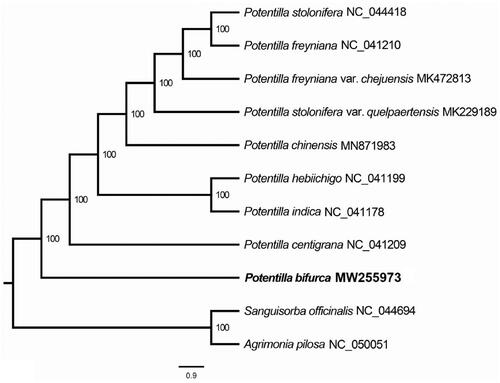Abstract
Potentilla bifurca L. is a perennial herb in China, which has high ecological and economic values. Its complete chloroplast genome was reported in this study for the first time. The whole chloroplast genome was 157, 902 base pairs in length with 129 genes, including 84 protein-coding genes, 37 tRNAs, and 8 rRNAs. The maximum likelihood phylogenetic analysis revealed that the species of P. bifurca was isolated first among the genus Potentilla. This result will be helpful for the conservation and phylogeny programs of the genus Potentilla.
Potentilla bifurca L. is a perennial herb as a member of the Potentilla belonged to the family Rosaceae and widely distributed in China. As a creeping-rooted plant, P. bifurca plays an important role in the process of preventing steppe degradation, and usually becomes the dominant species in degraded ecosystems (Xu et al. Citation2019). Recent studies have shown that P. bifurca has high ecological and economic values on suppressing degradation, desertification and promoting vegetation restoration in arid and semi-arid grassland (Wang et al. Citation2014). Because P. bifurca has wide geographic distribution, and strong adaptability to stressful environments, it is important to understand how different evolutionary forces have sculpted the variation patterns in the genome of P. bifurca. In the present research, we characterized the whole chloroplast genome of P. bifurca and comprehended more about genetic information of this species, which can contribute to the understanding population genetics studies of P. bifurca.
For this study, P. bifurca were sampled from Duolun County (42°02′N, 116°17′E, 1324 m asl), Inner Mongolia Autonomous Region of China. A voucher specimen (HF2019003) was deposited at the Herbarium of Xi’an Botanical Garden of Shaanxi Province, China. DNA was extracted from the fresh leaves by modified CTAB method (Doyle and Doyle Citation1987). In order to construct the shotgun library, total genome DNA of P. bifurca was sequenced by Illumina Hiseq 2500 Sequencing System (Illumina, Hayward, CA). With P. stolonifera (NC_044418) as a reference, the qualified clean reads were assembled by NOVOPlasty (Dierckxsens et al. Citation2017). The complete chloroplast genome of P. bifurca was annotated by Geneious ver. 10.1 (http://www.geneious.com, Kearse et al. Citation2012) and online program Chloroplast Genome Annotation, Visualization, Analysis, and GenBank Submission (CPGAVAS2) (Shi et al. Citation2019). Finally, the validated complete chloroplast genome of P. bifurca was deposited in Genbank (Accession number MW255973).
The size of complete chloroplast genome of P. bifurca was 157, 902 bp in length, including a large single-copy region (LSC) of 86, 906 bp, a small single-copy region (SSC) of 18, 853 bp, and two inverted repeat (IR) regions of 26, 071 bp. The overall GC content is 37.0%. The genome contains 129 complete genes, including 84 protein-coding genes, 37 tRNA genes and 8 rRNA genes.
We used the complete chloroplast genomes sequence of P. bifurca and 8 other related species of Potentilla and two species: Agrimonia pilosa and Sanguisorba officinalis as out group from NCBI GenBank to construct phylogenetic tree. The 12 chloroplast genome sequences were aligned with MAFFT (Katoh and Standley Citation2013) and then the maximum likelihood (ML) tree was constructed by RAxML (Stamatakis Citation2014). The phylogenetic tree revealed that the species of P. bifurca was isolated first among the genus Potentilla with the support rate of 100% ().
Disclosure statement
No potential conflict of interest was reported by the author(s).
Data availability statement
The genome sequence data that support the findings of this study are openly available in GenBank of NCBI at [https://www.ncbi.nlm.nih.gov] under the accession no. MW255973. The associated BioProject, SRA, and Bio-Sample numbers are PRJNA679129, SRR13077143, and SAMN16807717 respectively.
Additional information
Funding
References
- Dierckxsens N, Mardulyn P, Smits G. 2017. NOVOPlasty: de novo assembly of organelle genomes from whole genome data. Nucleic Acids Res. 45(4):e18.
- Doyle JJ, Doyle JL. 1987. A rapid DNA isolation procedure for small quantities of fresh leaf tissue. Phytochemical Bull. 19:11–15.
- Katoh K, Standley DM. 2013. MAFFT multiple sequence alignment software version 7: improvements in performance and usability. Mol Biol Evol. 30(4):772–780.
- Kearse M, Moir R, Wilson A, Stones-Havas S, Cheung M, Sturrock S, Buxton S, Cooper A, Markowitz S, Duran C, et al. 2012. Geneious Basic: an integrated and extendable desktop software platform for the organization and analysis of sequence data. Bioinformatics. 28(12):1647–1649.
- Shi L, Chen H, Jiang M, Wang L, Wu X, Huang L, Liu C. 2019. CPGAVAS2, an integrated plastome sequence annotator and analyzer. Nucleic Acids Res. 47(W1):W65–W73.
- Stamatakis A. 2014. RAxML version 8: a tool for phylogenetic analysis and post-analysis of large phylogenies. Bioinformatics. 30(9):1312–1313.
- Wang ZY, Liang JH, Wang XF, Li LJ, Wang LQ. 2014. Effects of grazing intensity on root architecture of Potentilla bifurca in desert steppe. J Arid Land. 28:86–92.
- Xu XY, Qin YY, Cao JJ. 2019. Variation characteristics of Potentilla bifurca leaf stoichiometry along the elevation gradient on the northeastern Qinghai-Tibetan Plateau. Acta Ecologica Sinica. 39:9044–9051.

